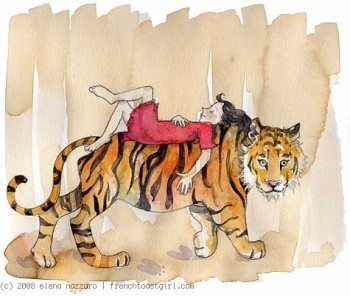Diane Duane's Blog: Out of Ambit, page 21
July 20, 2014
Recent tweets…

2014-07-19 through 2014-07-19 Continue Reading →
The post Recent tweets… appeared first on Out of Ambit.
July 17, 2014
In the “Something’s A Bit Wrong With This Sentence” department…

In the “Something’s A Bit Wrong With This Sentence” department…: “A Seattle man burnt down his house on Tuesday after trying to kill a spider that he found in the laundry room with a homemade blowtorch.” This was crossposted from… Continue Reading →
The post In the “Something’s A Bit Wrong With This Sentence” department… appeared first on Out of Ambit.
July 16, 2014
Bread and squirrels

So last night I was working late-ish, and it occurred to me that this would be a good time to bake some bread. In particular I wanted to test the Odlums “strong white” bread flour to see how it behaved… Continue Reading →
The post Bread and squirrels appeared first on Out of Ambit.
July 15, 2014
The sweet silver song of a lark

was originally famous for having come from the great Rodgers & Hammerstein musical and is now much better known on this side of the water for its association with (after the Gerry and the Pacemakers cover of it came out: you can hear it below). And the song is about as close as most people are likely to get to a real lark, these days, as the is just about the Nevertheless it was over the field above that I heard one the other morning when I was out walking. It stopped me in my tracks: it’s been easily a decade since I last heard one. And who knows if I’ll ever hear one again? The changes in their nesting areas (mostly open fields) in these islands have reduced their numbers by almost 90%. I hope they can hang on. It would be sad to lose that uprising song forever.
The post The sweet silver song of a lark appeared first on Out of Ambit.
lileks: Oh God the tables have turned please do not put me in…

:
Oh God the tables have turned please do not put me in your pants I am sorry I put you in my pants
I think I’d probably better stop reblogging these right now. Having enough trouble breathing right now as it is.
This was crossposted from DD’s tumblr , where it was published on July 15, 2014 at 03:58PM
The post lileks: Oh God the tables have turned please do not put me in… appeared first on Out of Ambit.
lileks: “Fargin’ Unicorns get adopted by the Gays, but I’m…

:
“Fargin’ Unicorns get adopted by the Gays, but I’m sitting around here all day waiting for the bisexuals to ring me up and say they need a mascot.”
In other news: HAS A TUMBLR.
…What next? Is Messiah going to show up all of a sudden?
This was crossposted from DD’s tumblr , where it was published on July 15, 2014 at 03:51PM
The post lileks: “Fargin’ Unicorns get adopted by the Gays, but I’m… appeared first on Out of Ambit.
July 13, 2014
DD Q&A: Creation, self-esteem, and running your own work down

(via
Hi Diane, I’ve been a fan for a long time. Read the YW books, Wounded Sky, and eventually the Door Into… books staring when I was a kid back in the 80s. Someday I’ll take a picture of the Hello Kitty notebook I owned circa 1984 where I wrote both Ed the shark’s name and Sherlock Holmes’ name surrounded by hearts. I was totally willing to marry either one of them. ;D
Anyway, when I started looking for more Sherlock stories after the BBC show premiered I got into reading fanfic, and eventually the amazing art on Tumblr. It was great to see someone whose books I’d always loved was right in there as a fan too.
Reading someone’s tags today, I noticed the latest example of something that makes my heart hurt a little every time I see it. The art (it was a short Sherlock comic strip) was great! Well laid out, engagingly drawn, funny, entertaining, etc. But the artist’s tags were all about how terrible it was. How she couldn’t write, how she couldn’t draw, etc. I know how hard it is to put your work (of any kind) out there and just let it speak for itself, but the prevalence of young girls making something amazing and then sharing it by saying “here’s this thing I did. It’s probably terrible,” just kills me. I can’t count how many posts I’ve seen people tag or comment that their art or they themselves are “trash”. I mean, I get that they’re self deprecating for comic effect, but…
I don’t know. Maybe learning to not put down your work before someone else gets a chance to is just something that has to be grown out of, but I also wonder if more of us older women should be saying something. I’d love to see girls say “here’s this thing I made [full stop]” if it still seems too hard to say “here’s this thing I made; I’m proud of it.” Just not tearing themselves down would make a world of difference, I think.
I guess I’m just curious if you have any thoughts to add. Thanks again for writing such enjoyable stories and building such cool worlds! May you live long and prosper.
First of all: thanks for the nice words. It’s always nice to know I’m getting the job done.
Re the self-esteem problem as regards talking about one’s work: I see a lot of this from girl creators too. (Yet also from the boys, until they gradually knuckle under or get pushed under the surface of the whole patriarchal never-say-anything-that-might-make-you-seem-weak crap, and get it institutionalized out of them.)
Part of the problem is that the creation of art (or indeed anything else useful) is unnerving business, because you’re essentially making the invisible visible: making something out of nothing — and even that phrase is culturally loaded. (“Don’t make something out of nothing!”: a classic putdown for overreaction.) Yet making Something out of Nothing is also, as it happens, what Gods do. (The classic western-culture version of this: Deity moves over the surface of the empty void, says, “Hmm. Light…” and bang! Light.)
So creation routinely frightens those who who do it — because the actual process of mastery of art takes a long time, and in the meanwhile you may frequently feel like you’re riding the tiger, only half in control, while your grip on the tiger’s ears is always threatening to slip. And creation frightens more badly those who don’t do it (not that you’ll ever easily get them to admit that), because they see you making Something out of Nothing and that’s not normal. Everybody gets a little freaked as a result, and it’s probably no surprise that the responses to the act of creation by both creators and spectators can get skewed — reactions based on fear not routinely being the healthiest ones.
(Adding a cut here, since more discussion and a brief how-to course in auctorial esteem lies below. Also, “pieces of shit”…)
One of the classic reactions, when you’re afraid that something is going to cause you pain, is to cause yourself the pain first — the rationale most likely being that at least that way you’re in control of something in the process: the amount of pain, if nothing else. And you see this in the damndest places.
It was in Hollywood (while I still lived near there) that I first heard, from a well-placed and fairly-well-known writer, the usage that William Goldman mentions in his famous
%20One%20of%20the%20classic%20reactions,%20when%20you're%20afraid%20that%20something%20is%20going%20to%20cause%20you%20pain,%20is%20to%20cause%20yourself%20the%20pain%20first%20(the%20rationale%20being%20that%20at%20least%20that%20way%20you're%20in%20control%20of%20something%20in%20the%20process.%20The%20amount%20of%20pain,%20if%20nothing%20else).
" target="_blank">Adventures in the Screen Trade: “POS.*” As in “Hey, wanna read this POS spec [script] I wrote?” …POS standing for Piece Of Shit. This usage is so commonly used out there that it’s genuinely shocking. Seriously, I thought Goldman had been exaggerating: I should have known better. But again and again you hear it, in what is (theoretically) a hotbed of smart, sharp, self-assured people: the quickest way to defuse criticism or deflect pain — dissing your own work in front of others. Do it before they do it to you. Do it first so if they do it, they’ll only be the second to say it and therefore the sting will be less.So plainly this isn’t just a problem for young girls. Nobody likes pain, be they young, mature, old, or any damn thing in between. And getting into this kind of habit to attempt to prevent it is way too easy.
(Let me briefly add for clarity’s sake that I’m perfectly aware of how educational and creative milieus in general, especially in the US, are skewed against girls and young women getting an equal chance to express themselves and their abilities, and these situations need to be dealt with, urgently. The point I’m dealing with here, though, is that the creator-negative-self-esteem situation’s endemic in human experience.)
Every person who makes art (verbal or visual), regardless of the shape of their physicality or the state of their gender, can benefit from learning how to assert the value of their work as it stands: the work (written or drawn or painted or danced or photoshopped or carved or whatever) as its own fact, as a self-proving statement that has the right to be evaluated on its own merits — just left alone to tell its own story. This is hard to learn how to do by yourself.
If I was going to attempt a short how-to guide, it would look like:
(a) Before you start: if you feel the urge to diss your own work, set it aside. Any artistic work that you take the time to do demands that you respect it first. Otherwise no one else will. But — more to the point — you are channeling one of the greatest and most ancient human urges: to make, and to be through your making. You are, in the archetypal sense at least, standing on holy ground. So act like it. Treat what you make with honor.
(b) Having done the work, get it out there.
(c) About the work itself, to its intended audience, say merely, “Here it is: I hope you like it.” And nothing else. It is neither your job to praise your own work in its presentation or to run it down when initially presenting it. Quiet self-confidence is the tone to take. Not feeling quietly self-confident / have never felt that way in your life? Fake it. We all do at one point or another. Just indicate the work and step back: let it do the job for which you created it, which is to communicate on its own.
(d) Wait for feedback. And while you wait, be quiet. Don’t be dumping your excitement or your nervousness where the audience can see it.
(e) When the cruel and nonconstructive feedback arrives — because it will — recognize it for just that and do not respond except with something very neutral like “I hear you. Thanks for taking the time to comment.” (No matter how much you want to rant and rave, no matter how much you hate even thanking them. Be the grownup about this, since they’re plainly not going to.) Do, however, examine the feedback for signs of anything that’s genuinely useful to you. If there’s nothing: kick it to the curb. But when evaluating, trust your instincts. Sometimes even a nasty asshole will put their finger on something that needs handling, and your duty to your art requires that you take that on board. But you don’t have to take the nastiness with it.
(f) When the positive feedback arrives — because it will (and hilariously, sometimes way more of it than usual will arrive about a piece of work that you’re none too sure about) — say “Thank you, I’m really glad you liked it!”, or something along those lines — and as little more as will go along with that stance of quiet confidence. Do not meet gushing with gushing. The squee (if any) belongs on the other side of the transaction. If it arrives, accept it gracefully. If the reader pauses to discuss at length something they really liked, you’re allowed a few more words about that to say (if you like) a little about where it came from or what was in your mind. Then step back again.
…And then (with the next piece of work) repeat. Repeat, repeat, repeat again and again until the process starts feeling more comfortable. It will never feel entirely comfortable. You are a creator, and creating in a universe where entropy is running will always be a challenging business. But it’s worth it.
…This entire issue is probably the core of a writing workshop, online or elsewhere. I need to think about this for a bit.
In any case, thanks for giving me an excuse to hold forth on this.
*The full quote: “(Piece of shit by the way is the standard terminology in Hollywood for a project. If you ask a producer what he’s working on, more than likely he will say, ‘Well, I’ve got this Western piece of shit I’m working on’ or ‘this piece-of-shit comedy.’)” You can see it in context in
The post DD Q&A: Creation, self-esteem, and running your own work down appeared first on Out of Ambit.
June 29, 2014
For Fairytale Friday: The Prince with the Three Fates

Once long ago in the land of Khem, there lived a King who greatly desired a son. For long and long no son was vouchsafed to him, but he would not give up hope. The King prayed to all the gods, giving generous alms to poor men and founding temples, and night and morning lay on his face in the great Temple of his city, praying every god and goddess to send him a son.
And as notice is often enough taken of such persistence, the gods took counsel together and at last decreed that a son should be born to the King. And when his wife’s time was fulfilled, she brought forth their firstborn boy. But also, since notice had been taken, then soon after the birth came the Hathors to decree a destiny for the child. And the first Hathor said, “His death shall be by the crocodile.” And the second said, “Or else by the serpent.” “Or else by the dog,” said the third; and then they vanished away.
The royal attendants standing by the child’s cradle heard all this, and went to tell the King. Then the King’s heart sickened within him, and the Queen’s likewise, that no sooner was their son newborn and in their arms than his death was foretold them. “What can we do?” the Queen said, grieving. “How may any mortal man elude his fate?”
“We will do what we can,” said the King. And he caused a house to be built in the midst of the desert, far from the haunts of man or beast. He furnished it with caretakers and servants and with all manner of good things from the royal house, meaning that the child should stay there and never go abroad. And so it was done; the King’s son was raised there in isolation, living the life of a prince in the midst of the emptiness.
He spent his childhood in that house, seeing none but his parents and the servants who waited on him. And it chanced one day that the young Prince was up on the roof of the great house looking down at the road that passed it by — this being the only way he could get a glimpse of the doings of the outer world, and one of his few great pleasures. And as he said on the roof looking out at the world, he saw men come walking down the road, with a strange four-legged creature trotting behind him.
The Prince spoke to the little pageboy who was with him to see to his needs, and said, “What is that creature walking behind the man down there on the road?” “It is a dog, your highness,” said the page. And the Prince, looking at it, thought that there was nothing he wanted more in the world. And he begged of the servants, “Let there be brought to me a dog like that.”
The servants were troubled and reluctant, for they knew the fates that had been foretold the Prince. They sent to his father the King to learn what to do. And the King, hearing of his sons great desire, relented and said, “Let there be brought to him a little pet dog, lest his heart be sad.” And behold, they brought him a little dog, a greyhound pup. The young Prince fed the puppy, and played with him and cared for him, and they brought each other great joy.
The days increased, and the years passed, and the child grew into a young man, tall and strong and well grown in all his limbs. He sent his father a message at last, saying, “Father, why am I kept here any longer? If I am fated to three evil fates, then at least let me follow my desire a while. Let me live before I die, and let the Gods do with me what is in Their hearts.” And though at first the King was reluctant, his son was as persistent as the King himself had once been in his prayers.
Finally the Prince’s father agreed to do is the Prince asked. He gave him fine armor, and every kind of weapon, and a noble chariot. And after they said their farewells, the King’s people conveyed the Prince and his dog, now well grown and in his prime, to the eastern lands. There they said to him, “Behold, the world and your freedom! Go where thou wilt, O Prince.”
And so, with his dog running after, the Prince drove his chariot northward following his heart into the desert. He thrived in this life, for the emptiness did not frighten him, he having been used to it from his earliest days. And the dog, happy in its travels with its master, caught all manner of game for the two of them, so they were never hungry. And they journeyed far.
It came to pass that one day the Prince, looking toward the horizon ahead of them, saw the light of Ra’s Sun glance off something far ahead. And behold, as they approached it, the Prince saw that it was a high tower; and as they approached it more closely still, that about the feet of the tower were pitched many pavilions of rich fabric and standards of great families.
Curious, the Prince rode up to these tents and greeted the young men who came out to meet him. The young men had their servants feed and look after the Prince’s horses and his dog, and themselves they took the Prince into the great tent they shared. They bathed him and perfumed him and anointed his feet, they gave him of their own food and wine, and then when he had eaten and drunk and was rested, they said to him, “Goodly young sir, where have you come from?”
“I come from Khem, from Egypt’s land,” said the Prince. “I am the son of an officer there. My mother died, and my father has taken another wife; and when she bore children to him, she began to hate me. So I have come away out of their house as a fugitive, to seek my fortune elsewhere.” And the young men embraced him, and kissed him, and said “You are welcome among us; fear nothing here.”
Having been welcomed, the Prince said to the young men, “What is it that you are doing here?” And they said to him, “This place is the land of Naharaina, and in that tower lives the only daughter of the petty king of Naharaina, as she has done since she was a child. But now comes the time when it has been decreed by the Hathors that she shall leave the tower and take a husband. And so her father the King has decreed that all we, the sons of the noblemen and princes of Naharaina, shall climb the tower and try to win to the Princess. But the only windows are seventy cubits up the tower’s side, and its walls are sheer and hard to climb.”
“May I also attempt this adventure?” said the Prince: for he thought of the loneliness of such a life, knowing it well, and was loath to leave another to it. And the young princes and noble men of Naharaina said, “Why should you not? We will attempt it together.”
The next day was one that was decreed for the climbing. As it began the Prince watched the young men attempt the tower, and examined it carefully, looking out for handholds and footholds and watching where the others succeeded and where they failed. And finally, in the heat of the day when the others did not like to climb, he made his attempt. The high Sun showed him the shadows of handholds and footholds more clearly than they could have been seen earlier in the day, so that the Prince with great patience and effort won up to the one of the windows, and entered the upper room, and found the Princess there.
His arrival astonished and delighted her, for she had seen the strange new arrival in the young men’s camp from her high vantage point; and in him she knew now that the decree of the Hathors was fulfilled for her. She embraced the Prince and kissed him, and while they sat down to talk, she sent a servant to tell her father the glad news.
To this King, the servant said, “Majesty, one of the people has reached thy daughter’s window.” And the king said, “Which of the princes is it?” “O King,” said the servant, “it is no Prince, but the son of an officer who fled the land of Egypt and the persecution of a stepmother who hated him.” And the King of Naharaina flew into a rage, saying, “What, shall I give my only daughter, a Princess and a daughter of Queens before her, to a ragged fugitive? Let him go back where he came from, and if he does not, he shall be thrown from the tower.”
A servant was sent to carry this message to the Princess. But when she heard it, the Princess seized the Prince’s hand and swore an oath by the gods, saying, “By the very soul and being of great Ra-Harakhti, if anyone lays a hand on you to take you from here, I will never eat again nor drink again; I will be dead within that hour!” And hearing of this oath, the King, both angry and afraid, sent men into that house to slay the Prince. But the Princess stood between him and those who would have slain him, and said, “By Ra’s great being, should any of you slay this noble youth, I will be dead by one of your swords in the next minute. I will not pass an hour more of life on this earth if he is parted from me; in less time than that, he and I will be sailing through the Tuat together, toward the weighing of our souls!”
Then together they went before the King. And he, seeing that the young man was of noble mien and bearing and well spoken, understood in his heart that this was one of high birth who was concealing the truth of his origins for some reason of his own. And seeing that the young man was handsome and strong and clever, and most importantly, that his daughter had come to love him instantly, the King saw in this the workings of fate and the decree of the Hathors, and resigned himself to it.
So the young man Prince was given the Princess of Naharaina to wife, and with her a great house, and servants and cattle and wide fields for their living, and all manner of other good things. And the Prince and Princess settled down to live happily together.
And as their days together lengthened they began to tell one another the tales and secrets of their lives: and by and by the Prince said to the Princess, “This fate has been ordained to me: to die either by the crocodile, or the dog, or the serpent.” Alarmed, his wife said, “Then let one kill the dog that follows you about all the day!” The Prince was horrified, and said, “I am not going to kill my dog, my good friend that I brought up from a puppy since I was a little boy!”
The Princess understood this, yet she feared for her husband. It seemed to her that perhaps her husband had been spared the fate of the dog, having lived so long with this one. But what of the other two fates? On their account she feared for him greatly, and desired him not to go forth in the world.
Yet he did, against her will. Time came that the Prince desired to look on his old homeland again, and with the Princess he went thither and stayed in a place prepared for them, a house near a mighty river. Now behold, from the river a great crocodile came forth, making his way toward the town where the Prince and Princess were staying. But also in that town was a powerful hunter and master of beasts, and when he saw the crocodile, he went to battle it, and caught it and bound it, afterwards keeping it (as he thought) penned up.
During this time, the Prince and his Princess stayed in that town, knowing nothing of this. They ate and drank and slept and walked and went about their lives; and after one such day the Prince came home and laid him down and slept. But his wife was troubled in her heart, she knew not why, and so she lay awake by him and watched late, with just a small lamp burning. And from a hole low down in the wall of their room, she saw a snake come forth.
Quietly the Princess rose and summoned a servant and bade him bring milk in a bowl (for all know that serpents cannot resist milk), and this she put in the serpent’s way. And the serpent came upon the milk and drank and was sodden and fell over upside down, and slept. The Princess then fetched a dagger and killed the serpent: and when it was well dead she woke her husband and said, “See how the good Gods have given this fate into our hands! Surely they will give the others into your mastery also.”
And her husband gave thanks for her, and for the Gods’ kindness, and sacrificed to them day by day.
So their life went on. And came a day when the Prince went walking in the fields. He was not alone: his dog ran along through the fields with him. The dog saw game in amongst the reeds of the river, bright ducks and other waterfowl, and went in to chase them. The Prince his master went after the dog. He came to the reeds of the river, and as the dog plunged into them, the Prince went after.
And lo, from among the reeds the crocodile came forth, escaped from where the strong man of the town had penned it. And it looked upon the Prince and said to him, “I am thy doom, O Prince, following after thee…”
***
And here the story ends. The rest of the page of the papyrus on which it is written (, in the British Museum) is lost.
Few fairy tales are more poignant than this, because — despite the presence of tropes that are so familiar to us: the Sleeping Beauty-ish prince and the Rapunzel-ish princess in their towers, the Prince’s cursed adulthood, the supernatural forces appearing at their births, even the offhand, artful (lying) backstory about the hated stepchild fled from a cruel home — we can never know for sure what ending the original storyteller(s) intended. There are versions of this story all through print and all over the web that attempt to stick happy endings (and tragic endings and any old kind of endings) onto the ancient, achingly unfinished narrative — upon the final truth of which the silence of millennia has descended beyond any attempt of ours to complete it.
If there is a heaven for writers, and a bar in that heaven, I would like to look this storyteller up there (after the paired business of breath and blood are done) and buy them a beer (beer was big in Egypt…) and find out how it ended. In the meantime, fate and mortality and the fragility of material being speak with their own voices, beyond our ability to silence them:
“I am thy doom, O Prince, following after thee…”
(This version of the Prince’s Tale is adapted from Egyptian Tales, Second Series, XVIIIth To XIXth Dynasty by W. M. Flinders Petrie, first published in 1895.)
The post For Fairytale Friday: The Prince with the Three Fates appeared first on Out of Ambit.
June 11, 2014
Crowds retrieve 100,000 books dumped in skip

Almost 100,000 new books were dumped into a skip outside a Derry bookshop today after the receiver ordered that the contents of the shop, which closed two years ago, should be disposed of.
…The books, valued at £60,000 (€74,253), were all new.
…As word quickly spread crowds descended on Bishop Street to avail of the book bonanza. Many motorists double parked causing temporary traffic jams as they helped themselves to dozens of the books.
Looking on as the skip was filled and re-filled with the books was Peter MacKenzie, the former joint owner of the Bookworm bookshop.
“I opened the book shop in 1978 and it was my life’s work until I was declared bankrupt in 2012.
“The books were my assets which were seized. The building was also seized and now it has been for sale for the last two years with an asking price of £375,000.
“Four years ago the same building was valued at just over £2 million.
“It’s heartbreaking to see what was once my life’s work being dumped into a skip but at least the books are being grabbed by members of the public and fair play to them”, he said.
This was crossposted from DD’s tumblr , where it was published on June 11, 2014 at 10:31AM
The post Crowds retrieve 100,000 books dumped in skip appeared first on Out of Ambit.
June 5, 2014
Hardware issues


Those of you who may remember the above image from a week and a half or so ago might be curious about how things have been progressing.
Briefly, not real well.
(Inserting a cut here (on the Tumblr side) to shield the eyes of innocent onlookers from the discussion of painful technical issues. The tl;dr version: My big work computer is screwed, I’m going to be fixing it for days, I will be cranky while this happens, my apologies in advance for an anticipated decrease in cheerful posts. (sigh))
Having tried everything one normally tries inside the case when a drive has non-noisily failed — swapping power and data cables around, checking everywhere for loose or dirty connections, fiddling with the BIOS (insofar as I dare to… I don’t like messing with the BIOS: there is nothing more pathetic and annoying than a motherboard you fried yourself), I then turned to out-of-case remedies and ordered in a SATA drive enclosure (we needed one anyway…) so that I could test the drive using a USB connection and find out whether any data could be reclaimed from it at all.
So yesterday the enclosure arrived. (Along with a Seagate 3-Tb external drive for backing things up from now on.) Very nice, too: sleek design, pretty. With due care the failed drive was put into it and powered up.
Nada. (Or as I originally just typed, Dana, which as Irish people will tell you is another thing entirely. )
So the situation is as follows:
(a) I now have a failed boot drive that will have to be sent off for data recovery in a clean room. What diagnosis I can perform at this end suggests that the failure was very likely electronic (drive board chipset failure, a short, etc etc) rather than mechanical, which is about as good as the news gets at this end: probably the disk platters will not have been damaged. Nonetheless this is going to be annoying and expensive to recover from.I haven’t actively started soliciting quotes yet, but my best guess suggests that if I get away with paying as little as €500 for recovery, I should count myself lucky. It could be double or triple that. (sigh) I will also have to spend a while wondering whether it’s worth sending the thing off for recovery at all, as I have no definitive list of What Used To Be There to compare against What’s there Now in the files restored from backups. (See (b).) I think I know. But then I thought the backups were complete and that most important program installs had been done to the 1Tb F: drive.
Gaaaah.
(b) While there are fairly recent backups of C: drive material (the most recent was May 18th, [heavyirony] whoopee, happy birthday to me [/heavyirony]), they are not as complete as I wish they were: some directories in the C: drive that should have been tagged for backup were not. (Mea culpa, mea bloody maxima culpa.) Some of them are/were quite important, like my installation of Dragon Naturally Speaking, Scrivener and so forth. Now, these can be reconstructed: in almost all cases I still have, or can quickly recover, the original installation media / files. But doing so, weary piece by piece — including in some cases having to install original files and then their upgrades, one after another — is going to take days of time that I really wish I didn’t have to spend right now. (While I am also busy finishing a writing project.) Ah well.
(c) The backups that did restore haven’t quite settled in at the W7 system end. In particular, user profiles from the old installation, though their files are all there, have not re-manifested themselves in W7 as yet… so that desktops are MIA/unavailable, and everything has to be searched for before it can be used or worked on. (And if the profiles don’t come back after a few reboots, I’m going to have to start working out how to make them come back. Oh joy. The Descent Into The Registry: “Abandon Hope All Ye Who Enter Here.” Gaaaaaaah x2.)
…So. Those of you who follow me may find me a little less forthcoming with posts than usual for the next 3-5 days, and if my tone sounds a little strained when I do post, you’ll know why Please bear with me until I get this mess as sorted as as it can get in the short term.
Thank you. :)
This was crossposted from DD's tumblr http://ift.tt/1pHE23c, where it was published on June 05, 2014 at 11:18AM
The post Hardware issues appeared first on Out of Ambit.



